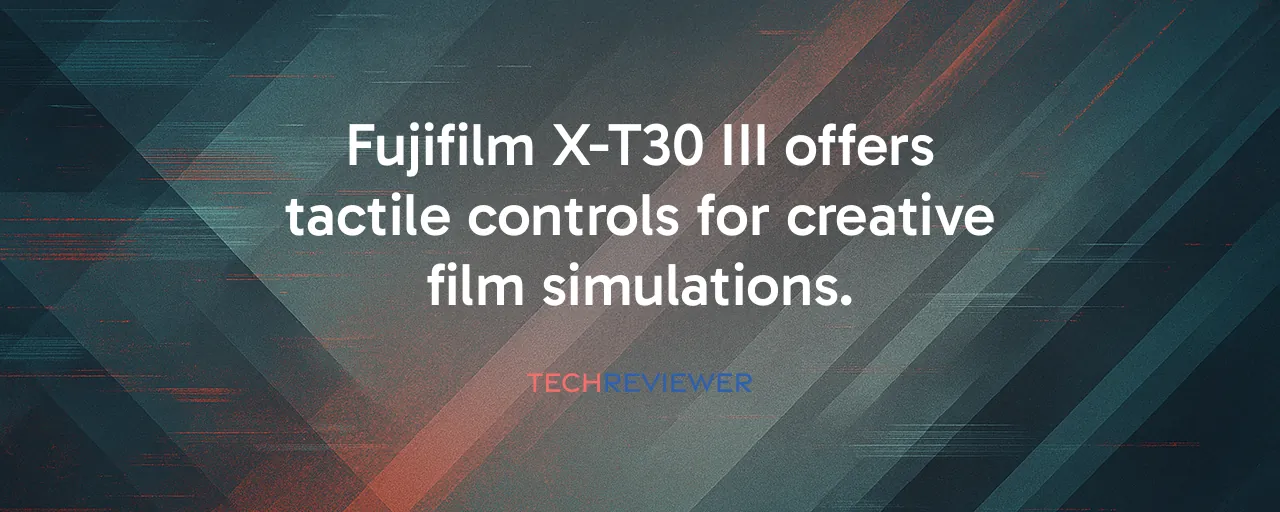A Camera That Feels Like a Creative Partner
Fujifilm's X-T30 III, announced on October 23, 2025, and set for late November availability, stands out as a mirrorless camera built for photographers who crave hands-on control without diving into a sea of menus. With a dedicated Film Simulation dial offering 20 vibrant, film-inspired color profiles, this compact camera invites smartphone upgraders to explore photography as an art form. Priced at $999 for the body, it's a bold entry in a market where smartphones dominate casual snaps, yet it carves a niche for those seeking something more tangible.
The camera's appeal lies in its simplicity. Twist the dial, and you're instantly shooting in modes like REALA ACE for true-to-life colors or NOSTALGIC Neg for punchy, soft tones. No need for hours of editing. This tactile approach resonates with a generation hooked on Instagram and TikTok. Fujifilm's retro aesthetics have become a visual language for creators chasing authenticity.
Smartphone Upgraders Find a New Playground
For smartphone users, the leap to a dedicated camera can feel daunting. Settings like aperture or ISO sound like a foreign language. Fujifilm tackles this with an AUTO mode that delivers stunning results without technical know-how, while the Film Simulation dial lets beginners play with creative looks right away. At 378 grams, the X-T30 III is light enough to toss in a bag, yet its 26.1-megapixel sensor and X-Processor 5 outshine any phone's tiny chip in low light or dynamic range.
Some content creators have reported success using the X-T30 III to post unedited JPEGs with Velvia film simulation on social media, citing its vibrant, authentic look as a way to stand out in a crowded digital space. This reflects how Fujifilm empowers users to skip complex editing while maintaining creative expression.
Standing Up to Canon and Sony
The X-T30 III enters a competitive market alongside Canon's EOS R10 ($999), while also positioning itself against older models like Sony's a6400, which remains available but has not seen recent updates. Both rivals offer strong autofocus and lens ecosystems, but Fujifilm leans on its unique color science, rooted in 70 years of film expertise. Unlike Sony's clinical precision or Canon's all-rounder approach, Fujifilm prioritizes artistic expression. Its 425-point autofocus, powered by AI, tracks everything from faces to drones, keeping pace with competitors.
Sony's a6400, for instance, benefits from a vast E-mount lens lineup, appealing to creators who prioritize video. A vlogger in Los Angeles noted on TikTok that the a6400's flip-out screen and lens-based stabilization made it her go-to for run-and-gun shoots. Fujifilm does not include in-body image stabilization, but compensates with digital stabilization for video, helping reduce shake during handheld recording. For sharper results in low light, stabilized lenses are recommended, which can increase overall system cost.
Why Retro Still Rules in a Digital World
Fujifilm's focus on analog-inspired controls taps into a cultural wave. Gen Z photographers, especially, are driving a film photography revival, with vintage aesthetics trending across social media. The X-T30 III's dial-based interface feels like a nod to classic cameras, yet it packs modern firepower like 6.2K video at 30fps and 425 shots per charge. This blend of old and new bridges the gap for users who want creativity without complexity.
Market data backs this up. The digital camera market with interchangeable lenses is projected to reach $7.8 billion by 2033, driven by enthusiasts and professionals seeking tools that smartphones can't match, with mirrorless systems dominating this segment. Fujifilm's X-mount ecosystem, with over 40 lenses, offers flexibility for growth, from budget zooms to pro-grade primes. While smartphones like Google Pixel or iPhone excel at computational tricks, they can't replicate the tactile joy of twisting a dial to transform a shot.
Lessons From the Field
Fujifilm's strategy teaches a key lesson: differentiation matters. By emphasizing tactile controls over computational wizardry, the X-T30 III carves a space where smartphones can't follow. Compare this to Sony's approach with the a6400, which doubles down on technical prowess but lacks Fujifilm's artistic soul. Sony's camera thrives in fast-paced video workflows, but its menu-heavy interface can overwhelm newcomers.
Another takeaway is community power. Fujifilm users on platforms like Instagram share custom film simulation recipes, creating a vibrant ecosystem that fuels engagement. This organic buzz, seen in Jane's story, shows how user-driven content can amplify a brand's reach. For Fujifilm, the X-T30 III isn't just a camera; it's a gateway to a creative community that keeps photographers coming back.
